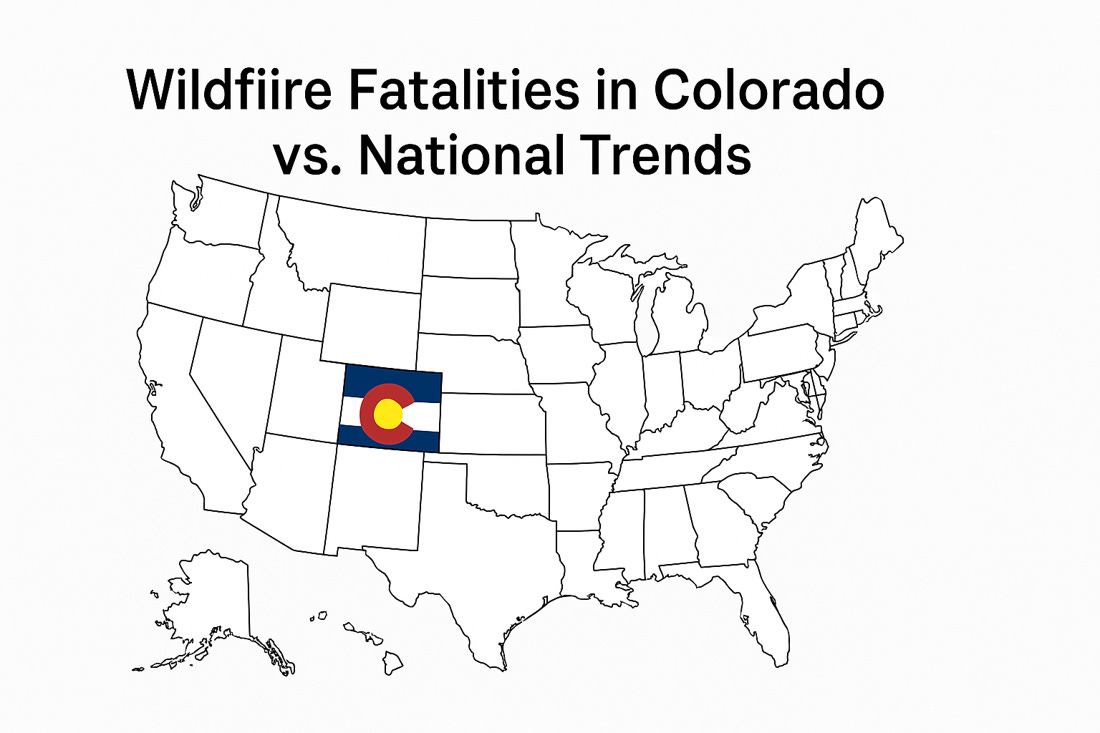Wildfire Fatalities in Colorado vs. National Trends (1999–2024)
Introduction
This analysis was developed as part of a wildfire evacuation planning project for a Colorado jurisdiction. It addresses a key stakeholder question: How do wildfire-related civilian fatalities in Colorado compare to national patterns over the past 25 years?
Drawing from incident records, after-action reports, and media accounts, this report summarizes where, when, and how wildfire fatalities have occurred, with a focus on evacuation timing and decision-making. The goal is to identify common factors and lessons that can inform future preparedness and planning efforts in the wildland-urban interface (WUI).
Wildfire Fatalities in Colorado
Over the past 25 years, civilian fatalities from wildfires in Colorado have been relatively infrequent but consistently tragic. Fatalities are typically concentrated in a few high-consequence events, with most occurring at or near the victims’ residences. In nearly every documented case, individuals either did not evacuate or were overtaken by fire before they could escape. The following incidents illustrate these trends:
Lower North Fork Fire (March 2012): This fast-moving wildfire, sparked by an escaped prescribed burn, killed three residents southwest of Denver. All victims were found in or near their homes. Investigations revealed that some evacuation notifications failed to reach residents in time, and at least one victim had prepared to leave but never received an alert before the fire arrived.
Waldo Canyon Fire (June 2012): In Colorado Springs, this fire destroyed 346 homes and resulted in two fatalities. The victims, a 74-year-old man, and a 73-year-old woman, were found inside their home in the Mountain Shadows neighborhood. They had not evacuated before the fire overtook the area.
Black Forest Fire (June 2013): At the time, this was Colorado’s most destructive wildfire. Two individuals died while attempting to evacuate from their home. They were discovered in their garage with vehicle doors open, suggesting they were loading belongings or preparing to leave when the fire arrived. While located at their residence, this case is one of the few in Colorado involving deaths during the act of evacuation.
East Troublesome Fire (October 2020): In Grand County, an elderly couple, ages 86 and 84, chose to remain in their home and shelter in the basement rather than evacuate. Both perished when the fire moved rapidly through the area. Their remains were recovered from the home’s debris.
Marshall Fire (December 2021): The most destructive fire in Colorado’s history caused two civilian fatalities. In one case, a 91-year-old woman was unable to evacuate and died in her home in Superior. In the other, a 69-year-old man died inside his residence near the point of ignition. In both instances, evacuation was not completed before the fire arrived.
Key Pattern
In Colorado, civilian wildfire fatalities overwhelmingly occur on residential properties, typically inside homes or attached structures such as garages. Nearly all fatal outcomes resulted from an inability or decision not to evacuate in time.
National Wildfire Fatality Trends
At the national level, civilian fatalities from wildfires are more frequent and have occurred across a broader range of circumstances. While many deaths have occurred inside homes, especially when residents chose to shelter in place, numerous incidents also involve fatalities during attempted evacuations, including those in vehicles or on foot. The following high-fatality wildfires illustrate national trends:
Camp Fire, California (2018): The deadliest U.S. wildfire in over a century claimed 85 lives. Analyses found that approximately 60% of identified victims died inside their homes, about 20% just outside (in yards or driveways), and the remainder in vehicles while trying to flee. The fire spread incredibly fast, leaving little time for evacuation. Many victims were elderly or mobility-impaired, contributing to delayed responses.
Tubbs Fire and Other California Fires (October 2017): The Tubbs Fire in Santa Rosa and concurrent fires in Napa and Sonoma Counties caused a combined 44 civilian deaths. Most victims were found in residential areas, and many were unable to evacuate due to mobility issues or a lack of warning. Some perished outdoors, suggesting last-minute flight attempts.
Cedar Fire, California (2003): Fifteen people died in this wind-driven wildfire in San Diego County. Several civilians were overtaken by flames while trying to evacuate, including some in vehicles. Others who delayed leaving were caught inside their homes as the fire advanced.
Chimney Tops 2 Fire, Tennessee (2016): This fire killed 14 civilians as it spread into Gatlinburg from Great Smoky Mountains National Park. Victims died in a range of circumstances, including in homes, rental cabins, and while evacuating. One fatality resulted from a vehicle crash during evacuation, and another was due to a medical emergency exacerbated by the fire.
Oregon Labor Day Fires (2020): Multiple fast-moving fires in Oregon led to at least 11 fatalities. Several occurred during evacuation attempts, including victims found in burned vehicles or overtaken while fleeing on foot. Others died inside homes that were overrun by fire.
Lahaina Fire, Hawaii (2023): Though outside the continental U.S., this event is critical to national understanding. The fire killed at least 97 people, many found in homes or in vehicles amid stalled traffic. The fire’s speed and the urban setting illustrate the risks of both sheltering in place and late evacuation in densely populated areas.
Key Pattern
Nationally, civilian fatalities during wildfires are split between those who stayed in place and those caught during evacuation. Unlike Colorado, where most deaths occurred indoors, several large-scale incidents across the U.S. involved significant numbers of people dying in vehicles or outdoors while trying to escape.
Cross-Cutting Observations
While each wildfire incident is shaped by unique factors, the circumstances leading to civilian fatalities show striking similarities across regions. The following observations highlight the most consistent and consequential themes that emerged from the analysis.
Fatalities Inside Structures
A substantial share of wildfire victims are found inside homes or other buildings.
These fatalities often involve individuals who received evacuation warnings too late, chose to stay, or were physically unable to leave.
In typical residential structures, sheltering in place is rarely survivable unless the building has been specifically hardened to withstand wildfire conditions, which is a rarity in WUI areas.
Fatalities During Evacuation
Many deaths occur during evacuation efforts, particularly in vehicles. Victims may be overrun by fire if traffic is congested, routes are blocked, or the fire is moving faster than expected.
Some individuals abandon vehicles and flee on foot but are overcome by smoke or heat before reaching safety.
Cases from California, Oregon, and Tennessee demonstrate that delayed evacuation can be just as deadly as staying behind.
The Critical Role of Timing
Across both Colorado and national incidents, a clear conclusion emerges: evacuation timing is often the decisive factor in civilian survivability.
Fatalities generally occur when individuals wait too long to leave or when warnings do not reach them in time.
Early, proactive evacuation is the most effective strategy to prevent loss of life in WUI settings.
Conclusion
There is no single national database that comprehensively tracks civilian wildfire fatalities, making pattern analysis dependent on case studies, official reports, and journalistic investigations. Despite these limitations, the available evidence reveals consistent trends:
In Colorado, fatalities are typically associated with residents who did not evacuate in time and died inside structures.
Nationally, in addition to structure-related deaths, a substantial number of victims perish during evacuation—particularly in vehicles.
In both contexts, delayed evacuation is a recurring factor in civilian deaths.
For jurisdictions facing WUI wildfire and wind-driven fire risk, the lesson is clear: improving early warning systems, increasing public awareness of evacuation triggers, and enabling timely evacuations, especially for vulnerable populations, are essential to reducing wildfire fatalities.




